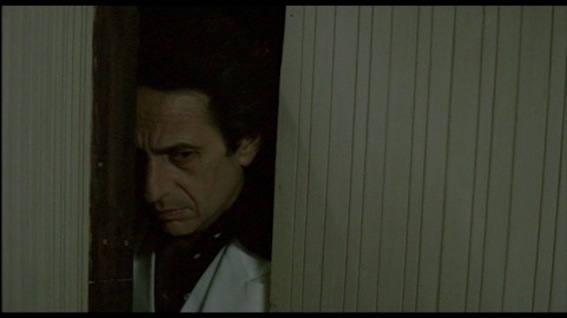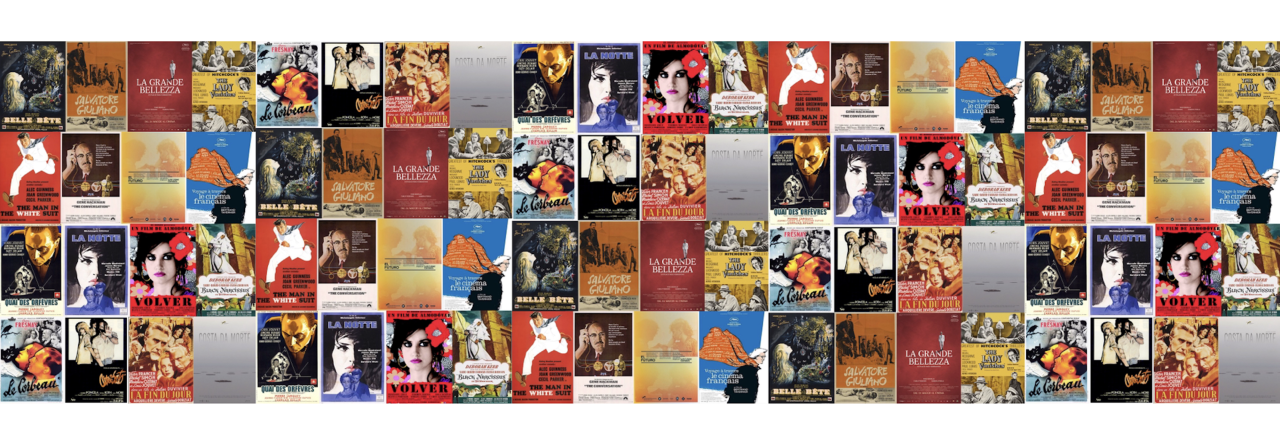This post was originally published on the old blog in November 2013 (Update, August 2017: where I have reprinted something here, I have decided to remove the contents of the original on the old blog and instead leave a link there to the new site (it doesn’t make much sense to have the pieces appear in two places)). Pablo Larraín’s new film, The Club, is released in the UK today (although apparently it’s not reaching my part of the country until the middle of April) – so I thought it was worth revisiting his previous films. The post has mainly been edited so that references to dates make sense but I’ve also simplified a couple of sentences.
I saw No (2012) in the cinema in early 2013. Although I hadn’t yet seen the two earlier films, I realised that No‘s undercurrent of alegría marked it as distinct within Larraín’s trilogy given that all three relate to Chile under Pinochet; No is like the gulp of air taken after you’ve been held under water for too long.
And life under water is shown to have been a grim and dark place. The first film – Tony Manero (2008) – is set in the darkest period of the dictatorship, in around 1977-78. The choice of year seems to have been partly shaped by the fact that Saturday Night Fever was in cinemas at that point – both the extras on the DVD and interviews contemporaneous to the film’s release reveal that the starting point was a photo of a man, which inspired in Larraín the idea of a killer who just wants to dance. In the Q&A on the DVD, Alfredo Castro (who plays Raúl, the man who wants to be ‘the Chilean Tony Manero’ in a TV dance contest) says that when they realised that the Travolta film was released in Chile in that period, they saw that they could draw some interesting parallels between the character’s behaviour and that of the State. Operating in a general atmosphere of fear and the absence of morality, Raúl doesn’t see why he shouldn’t always get his own way – so he kills in order to fulfil his dancing dream. Abhorrent as Raúl is, and despite the absurdity of his behaviour being in pursuit of the chance to win a TV lookalike / dance contest (Jonathan Romney talks of the first two films’ ‘grotesque absurdism’ (2013: 28)), the film’s occasional jet-black humour (not so much the banality of evil as the mundanity that underpins Raúl’s singleminded attention to detail in his quest to ‘be’ Tony Manero – “Two buttons?”) is undercut by the intrusion of the dangerous reality (police raids and a background undercurrent of the simmering threat of violence).

Alfredo Castro is the reason I wanted to write about the films because he turns in extraordinary and completely transformative performances both in Tony Manero and Post Mortem (he takes a supporting role in No). I don’t know why – having focussed on actors for a long time in my research – but I am still surprised when an actor turns out to be completely unlike how he appears onscreen in a given film. Castro appears in the DVD Q&A, looking not just younger and more animated, but positively rejuvenated in comparison to his appearance as the pasty and almost-jaundiced Raúl. I’ve been trying to decide whether he should be described as vulpine or vulture-like (he is frequently shown in profile, drawing attention to a prominent nose) – Raúl both scents danger (he often surreptitiously observes acts of violence being carried out by others) and also circles around in the aftermath (whether relieving an unconscious man of his watch and jewellery or faking a good samaritan act with an old lady). Castro’s performance is a composition of costume (the suit) and body language, alternating between the peacock-like strut on the dancefloor and scurrying rat-like run with which Raúl makes his way around the city (he has an in-built sensor for the approach of bigger animals – he’s frequently seen hiding in doorways or behind mounds of rubble as either the military or the police patrol the area). I found it interesting that his focus is on Tony Manero, the character, rather than John Travolta, the actor (Raúl walks out of a screening of Grease with a look of incomprehension). Castro says in the Q&A that although they knew the character would be a dancer, they wanted to avoid the ‘perfect’ style of American musicals. The dancing in Saturday Night Fever is athletic rather than elegant, and perhaps more importantly is also relatable to Raúl’s social class and to the street. The restraint of Castro’s performance is made clear in the two instances when emotion floods Raúl’s face: being moved to tears in the cinema, watching Saturday Night Fever; and when he is applauded after his TV performance (his reaction here doesn’t happen after the applause at the earlier lodging-house show). On both occasions he is transformed before our eyes.

The second film, Post Mortem (2010), moves further back in time to September 1973 and the military coup. It is a quietly unsettling film, and very different stylistically to the other two films. The theme (or sense) of surveillance runs through all three films – the handheld camera work in Tony Manero suggests a city under constant watch, while in No it evokes the intimidation of the security forces. Post Mortem‘s very elegant and formal framing is closer to voyeurism, indicated in our introduction to Mario (Castro) where he is standing in front of his main window, waiting for his showgirl neighbour Nancy (Antonia Zegers – luminously fragile but also playing Nancy as narcissistic and flaky enough to truly be a danger to others) to arrive home. The idea of a window is maintained by the letterbox framing throughout the film, which also suggests a restricted view: things frequently happen just out of shot (I had headphones on when I was watching it and the sound is also frequently positioned to the side or somewhere behind you), below the frame. One example is the way that Mario (and the viewer) misses the raid on Nancy’s house (we hear explosions and shouting) because Mario is looking away from the window while he is in the shower and the camera stays on him (observing him through the window). But this is also possibly a comment on people deliberately not looking – averting their eyes to an unpalatable reality (and trying to avoid being seen themselves).
Mario is a grey creature, Castro’s wolfishness from Tony Manero completely gone, his face hidden behind a curtain of light grey hair, and much like one of the cadavers whose post-mortems he records for the pathologist; he is one of the walking dead. But he is also attempting to be invisible, to get along, and not draw attention to himself – something that his apparently already deadened nature helps him with. In contrast, his female colleague (Sandra – Amparo Noguera, who played Raúl’s girlfriend in Tony Manero), although presented in an equally pallid palette of colours (costume, but also her complexion) cannot inure herself to the piles of corpses that start to stack up as the military coup unfolds; I didn’t take this to be a representation of the ‘hysterical female’, but rather someone who is fervently trying to cling to what she believes in and what she ‘knows’ in the face of obstruction, obfuscation, and denial. One gets the sense early on that this story is not going to end well, and the final wordless sequence silently foretells the horrors that were still to come for Chile in the aftermath of the coup.
Many of the same actors (Castro, Zegers, Noguera, and others) appear in all three films, but in No Gael García Bernal comes centre stage as advertising whizz-kid René Saavedra, the strategist behind the ‘No’ campaign in the referendum that would finally oust Pinochet. The choice of lead perhaps speaks to the representation of a younger generation, hope and alegría on the way, but the Mexican actor also brings with him a measure of ambiguity that suits the character; we are never really sure whether René believes in the ‘No’ cause or simply likes a challenge and views democracy as another product to sell (something suggested by his using the same lines when he introduces the first referendum piece as when he introduces the advertising promos for a soft drink (at the start of the film) or a new telenovela (at the end of the film)). Either way, his youthfulness fits with the aesthetic of the film – utilising U-matic film so as to be able to seamlessly blend archival footage into the film (about 30% of the film is archival footage according to a Larraín interview on the DVD – they called up the people who appeared in the original ‘No’ campaign and use them to play themselves, so that on the monitors the original footage shows their younger selves while they appear within the film itself as they are now, 24 years on, ‘history […] written on their bodies’ in Larraín’s words) – the video ‘feel’ of the footage and naturalistic lighting (lens flares and all) suggesting youthful adventure and moments caught on the hoof (not unlike the way the ‘No’ campaign itself was shot).

Alfredo Castro again transforms himself, here playing René’s lizard-like employer, an advertising executive who sides with the ‘Yes’ campaign (eventually taking it over in response to what the ‘No’ team manage to pull together) but who nonetheless recognises talent and engages in a cat-and-mouse provocation with the younger man. The back-and-forth between Lucho (Castro) and René, an almost affectionate bickering that has an undercurrent of real threat to it, and Lucho’s private talks with the Prime Minister (Jaime Vadell, who played the main pathologist in Post Mortem), provide much of the film’s humour (in addition to some of the absurdities of the world of advertising, and small touches such as the cleaner at the ‘Yes’ headquarters frequently whistling the ‘No’ campaign’s jingle); the lighthearted tone of the film mirrors the ‘No’ campaign’s ‘Happiness is coming’ sunny representations, in sharp contrast to the earlier two films. However the film still points to the darkness beyond that sunniness, whether in witness testimony about the disappeared, the State’s surveillance and attempted intimidation of the ‘No’ participants, or the cacophonous range of political opinions among the opposition. The latter includes René’s radical estranged wife (Zegers) who tells him that in taking up the challenge, he is playing by Pinochet’s rules and by extension validating what many on the Left thought would be a rigged outcome. Although the end of No is ambiguous (Larraín is quite pragmatic about the limitations of what was achieved and what Pinochet’s lasting legacy for his country was – see the interviews on the DVD), my lasting memory of the film from my first viewing was of sunshine. The trilogy goes out on a euphoric high.
